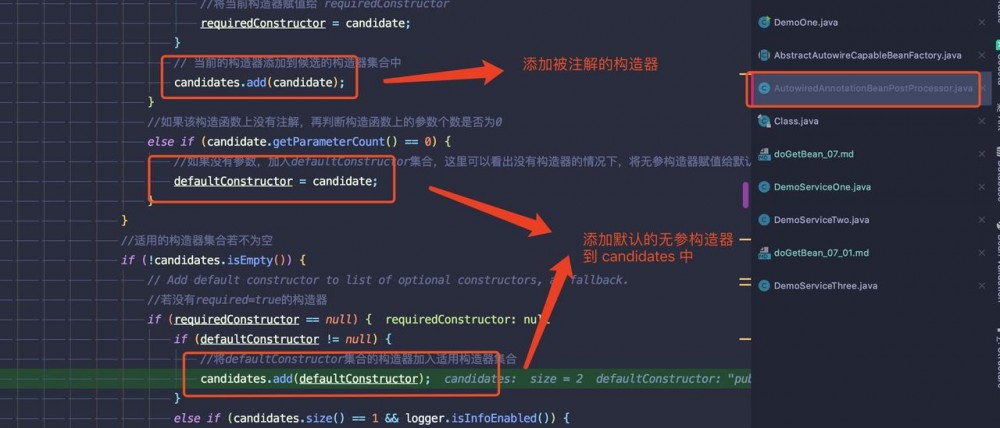走过路过Spring推断构造器不要错过哦~
找到更合适的构造器
1.没有最合适的,只有更合适的
上一篇文章中,我们说到了Spring确定有哪些构造器他可以使用,这一篇文章中,我们将来分析Spring是如何找到一个最合适的构造器。
@Service
public class DemoServiceOne {
DemoServiceTwo demoServiceTwo;
DemoServiceThree demoServiceThree;
public DemoServiceOne(){
}
@Autowired(required = false)
public DemoServiceOne(DemoServiceTwo demoServiceTwo){
this.demoServiceTwo = demoServiceTwo;
}
@Autowired(required = false)
public DemoServiceOne(DemoServiceThree demoServiceThree, DemoServiceTwo demoServiceTwo){
this.demoServiceTwo = demoServiceTwo;
this.demoServiceThree = demoServiceThree;
}
}
复制代码以上面这个类为例,Spring可以使用的构造器,最终确定为三个,如下图:
 这里简单说明一下,图片中构造器的确定是上一篇文章分析的内容,如有疑问可查看:如何确定构造器 这里通过下图简单说明,这几个构造器是如何添加到
这里简单说明一下,图片中构造器的确定是上一篇文章分析的内容,如有疑问可查看:如何确定构造器 这里通过下图简单说明,这几个构造器是如何添加到 ctors
中的: 
接下来就是本文的重点,通过构造器来完成对象的实例化。再有多个构造器的时候,是如何选出最合适的一个呢?
2.通过构造器来完成对象的实例化
public BeanWrapper autowireConstructor(String beanName, RootBeanDefinition mbd,
@Nullable Constructor<?>[] chosenCtors, @Nullable Object[] explicitArgs) {
// 实例化一个BeanWrapperImpl对象
BeanWrapperImpl bw = new BeanWrapperImpl();
this.beanFactory.initBeanWrapper(bw);
/**
* 确定参数列表,第一种通过BeanDefinition 设置
* 也可以通过 xml设置
* constructorToUse spring 决定采用哪个构造方法初始化
*/
Constructor<?> constructorToUse = null;
ArgumentsHolder argsHolderToUse = null;
// 定义构造方法要使用那些参数
Object[] argsToUse = null;
if (explicitArgs != null) {
argsToUse = explicitArgs;
}
else {
Object[] argsToResolve = null;
synchronized (mbd.constructorArgumentLock) {
//获取已解析的构造方法
constructorToUse = (Constructor<?>) mbd.resolvedConstructorOrFactoryMethod;
if (constructorToUse != null && mbd.constructorArgumentsResolved) {
// Found a cached constructor...
argsToUse = mbd.resolvedConstructorArguments;
if (argsToUse == null) {
argsToResolve = mbd.preparedConstructorArguments;
}
}
}
if (argsToResolve != null) {
argsToUse = resolvePreparedArguments(beanName, mbd, bw, constructorToUse, argsToResolve, true);
}
}
// 没有已解析的构造方法
if (constructorToUse == null || argsToUse == null) {
// 解析构造方法
Constructor<?>[] candidates = chosenCtors;
if (candidates == null) {
Class<?> beanClass = mbd.getBeanClass();
try {
candidates = (mbd.isNonPublicAccessAllowed() ?
beanClass.getDeclaredConstructors() : beanClass.getConstructors());
}
catch (Throwable ex) {
throw new BeanCreationException(mbd.getResourceDescription(), beanName,
"Resolution of declared constructors on bean Class [" + beanClass.getName() +
"] from ClassLoader [" + beanClass.getClassLoader() + "] failed", ex);
}
}
if (candidates.length == 1 && explicitArgs == null && !mbd.hasConstructorArgumentValues()) {
Constructor<?> uniqueCandidate = candidates[0];
if (uniqueCandidate.getParameterCount() == 0) {
synchronized (mbd.constructorArgumentLock) {
mbd.resolvedConstructorOrFactoryMethod = uniqueCandidate;
mbd.constructorArgumentsResolved = true;
mbd.resolvedConstructorArguments = EMPTY_ARGS;
}
bw.setBeanInstance(instantiate(beanName, mbd, uniqueCandidate, EMPTY_ARGS));
return bw;
}
}
// Need to resolve the constructor.
// 判断构造方法是否为空,判断是否根据构造方法自动注入
boolean autowiring = (chosenCtors != null ||
mbd.getResolvedAutowireMode() == AutowireCapableBeanFactory.AUTOWIRE_CONSTRUCTOR);
ConstructorArgumentValues resolvedValues = null;
/**
* 定义了最小参数个数
* 如果给构造方法的参数列表给定了具体的值
* 那么这些值的个数就是构造方法参数的个数
*/
int minNrOfArgs;
if (explicitArgs != null) {
minNrOfArgs = explicitArgs.length;
}
else {
/**
* 实例化一个对象,用来存放构造方法的参数值
* 主要存放参数值和参数值对应的下标
*/
ConstructorArgumentValues cargs = mbd.getConstructorArgumentValues();
// 这里 通过 new ConstructorArgumentValues() 的方式来实例化一个空对象
resolvedValues = new ConstructorArgumentValues();
// 确定构造方法的参数数量
// 在通过 Spring 内部给了一个值的情况下 表示构造方法的最小参数个数
// 在没有给的情况下 为 0
// mbd.getConstructorArgumentValues().addGenericArgumentValue("");
minNrOfArgs = resolveConstructorArguments(beanName, mbd, bw, cargs, resolvedValues);
}
//排序
/**
* 优先访问权限,访问权限相同,
* 通过构造器的参数个数来排序
*/
AutowireUtils.sortConstructors(candidates);
//定义了一个最小类型差异变量
int minTypeDiffWeight = Integer.MAX_VALUE;
// 有歧义的构造方法
Set<Constructor<?>> ambiguousConstructors = null;
LinkedList<UnsatisfiedDependencyException> causes = null;
// 循环所有的构造方法
for (Constructor<?> candidate : candidates) {
Class<?>[] paramTypes = candidate.getParameterTypes();
/**
* 判断是否确定的具体的构造方法来完成实例化
* argsToUse.length > paramTypes.length
* constructorToUse != null 表示已经有确定的构造方法来
* argsToUse.length > paramTypes.length 说明要使用的参数与指定构造方法的参数个数不匹配 break 结束循环
*
*/
if (constructorToUse != null && argsToUse != null && argsToUse.length > paramTypes.length) {
// Already found greedy constructor that can be satisfied ->
// do not look any further, there are only less greedy constructors left.
break;
}
// 当前构造方法使用的参数类型的个数,小于给定的构造方法的参数个数,
// 说明当前的构造方法不匹配,结束本次循环,继续下一次
if (paramTypes.length < minNrOfArgs) {
continue;
}
ArgumentsHolder argsHolder;
/**
* 这里 resolvedValues 必不为空
* 因为 在前面的处理过程中 explicitArgs 为null
* 所以 resolvedValues 通过 new ConstructorArgumentValues() 方式完成初始化
*/
if (resolvedValues != null) {
try {
/**
* 判断是否加了ConstructorProperties注解,如果加了,则把值取出来
*/
String[] paramNames = ConstructorPropertiesChecker.evaluate(candidate, paramTypes.length);
if (paramNames == null) {
ParameterNameDiscoverer pnd = this.beanFactory.getParameterNameDiscoverer();
if (pnd != null) {
// 获取构造方法的 参数列表
paramNames = pnd.getParameterNames(candidate);
}
}
/**
* Spring 内部只提供字符串的参数值,故而需要转换
* argsHolder 所包含的值就是转换之后的
*/
argsHolder = createArgumentArray(beanName, mbd, resolvedValues, bw, paramTypes, paramNames,
getUserDeclaredConstructor(candidate), autowiring, candidates.length == 1);
}
catch (UnsatisfiedDependencyException ex) {
if (logger.isTraceEnabled()) {
logger.trace("Ignoring constructor [" + candidate + "] of bean '" + beanName + "': " + ex);
}
// Swallow and try next constructor.
if (causes == null) {
causes = new LinkedList<>();
}
causes.add(ex);
continue;
}
}
else {
// Explicit arguments given -> arguments length must match exactly.
if (paramTypes.length != explicitArgs.length) {
continue;
}
argsHolder = new ArgumentsHolder(explicitArgs);
}
/**
* 定义了一个 类型差异量 typeDiffWeight: 这里要注意
* isLenientConstructorResolution 默认为true
* 这行代码的逻辑就是要确定一个差异值
*/
int typeDiffWeight = (mbd.isLenientConstructorResolution() ?
argsHolder.getTypeDifferenceWeight(paramTypes) : argsHolder.getAssignabilityWeight(paramTypes));
// Choose this constructor if it represents the closest match.
/**
* 下面代码是确定一个一个最匹配的构造函数来
* 首先:
* minTypeDiffWeight 是一个很大的值 typeDiffWeight 是一个负数,
* 这也就是 Spring 前面为构造方法排序的原因,其实默认,参数最多的构造 public 构造方法是最合适的
* 确保当前的 if 分支能够进入
* 在if 分支中 给要使用的构造方法,以及要使用的参数做了赋值
* 其中 minTypeDiffWeight = typeDiffWeight 就是用来判断哪个构造方法更合适,但是这样一来就会有一个问题,
* 下一次的 for 循环进入到这里,不满足 if 分支判断条件 进入的 else if 中
* 当进入到 else if 中
* 说明有两个构造函数比较合适,这个时候 spring 就不知道选哪个构造函数来完成实例了
*/
if (typeDiffWeight < minTypeDiffWeight) {
constructorToUse = candidate;
argsHolderToUse = argsHolder;
argsToUse = argsHolder.arguments;
// 最小差异值赋值
minTypeDiffWeight = typeDiffWeight;
// 重置有歧义的构造方法记录
ambiguousConstructors = null;
}
else if (constructorToUse != null && typeDiffWeight == minTypeDiffWeight) {
if (ambiguousConstructors == null) {
ambiguousConstructors = new LinkedHashSet<>();
ambiguousConstructors.add(constructorToUse);
}
ambiguousConstructors.add(candidate);
}
}
if (constructorToUse == null) {
if (causes != null) {
UnsatisfiedDependencyException ex = causes.removeLast();
for (Exception cause : causes) {
this.beanFactory.onSuppressedException(cause);
}
throw ex;
}
throw new BeanCreationException(mbd.getResourceDescription(), beanName,
"Could not resolve matching constructor " +
"(hint: specify index/type/name arguments for simple parameters to avoid type ambiguities)");
}
else if (ambiguousConstructors != null && !mbd.isLenientConstructorResolution()) {
throw new BeanCreationException(mbd.getResourceDescription(), beanName,
"Ambiguous constructor matches found in bean '" + beanName + "' " +
"(hint: specify index/type/name arguments for simple parameters to avoid type ambiguities): " +
ambiguousConstructors);
}
if (explicitArgs == null && argsHolderToUse != null) {
argsHolderToUse.storeCache(mbd, constructorToUse);
}
}
Assert.state(argsToUse != null, "Unresolved constructor arguments");
bw.setBeanInstance(instantiate(beanName, mbd, constructorToUse, argsToUse));